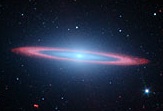 |
|
|
|
 |
 |
A frequently updated and diverse selection of inspiring and beautiful animations and video clips to stream and download.
To see selections click on the Multi Media subjects in the left column - and then click on the small images there. After the one you selected appears in a larger size in the right column click on the "Play" button.
|
 <
<
|
|
|
|
|
|
This movie shifts from the well-known visible-light picture of Messier 104 taken by the Hubble Space Telescope to infrared views from NASA's Spitzer Space Telescope. Messier 104 is commonly known as the Sombrero galaxy because in visible light, it resembles the broad-brimmed Mexican hat. However, in Spitzer's striking infrared view, the galaxy looks more like a "bull's eye."
Viewed from Earth, the spiral galaxy is seen nearly edge-on, just six degrees away from its equatorial plane. 50,000 light-years across, the Sombrero galaxy is considered one of the most massive objects at the southern edge of the Virgo cluster of galaxies. It is located 28 million light-years away, hosts a rich system of nearly 2,000 globular clusters and may harbor a super-massive black hole.
In Hubble's visible light image, only the near rim of dust can be clearly seen in silhouette. Recent observations using Spitzer's infrared array camera uncovered the bright, smooth ring of dust circling the galaxy, seen in red. Spitzer's infrared view of the starlight, pierced through the obscuring dust, is easily seen, along with the bulge of stars and an otherwise hidden disk of stars within the dust ring.
Spitzer's full view shows the disk is warped, which is often the result of a gravitational encounter with another galaxy, and clumpy areas spotted in the far edges of the ring indicate young star-forming regions.
The Sombrero galaxy is located some 28 million light-years away. Viewed from Earth, it is just six degrees south of its equatorial plane. Spitzer detected infrared emission not only from the ring, but from the center of the galaxy too, where there is a huge black hole, believed to be a billion times more massive than our Sun.
|
|